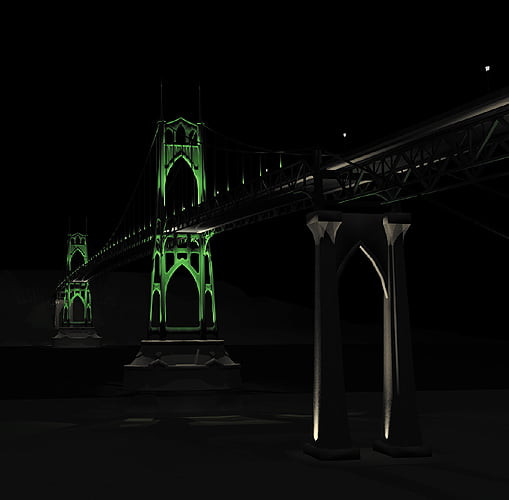Nestled in North Portland, where the Willamette River nears its confluence with the Columbia, stands the majestic St. Johns Bridge. This striking suspension bridge not only marks the northernmost crossing in Portland but also graces the site of the city’s last ferry service, connecting Linnton and St. Johns. The bridge’s name is a tribute to both the St. Johns neighborhood and James Johns, a pioneer settler who initiated the local ferry system in 1852 with a single rowboat, laying the foundation for future connectivity in the region.
Architectural Grandeur and Historical Significance
The St. Johns Bridge immediately captivates with its impressive 1,207-foot span, gracefully suspended between towering Gothic arch steel towers. These seemingly delicate yet robust structures rise high above the Willamette, making the bridge a visual marvel. Upon its completion in 1931, it proudly held the title of the longest suspension-type bridge west of the Mississippi River, a testament to its engineering prowess and scale. The bridge is the creation of David B. Steinman (1886-1960), a globally recognized bridge engineer, in collaboration with Holton D. Robinson of New York. To this day, the St. Johns Bridge remains the sole major highway suspension bridge within the Willamette Valley and one of only three in the entire state of Oregon, highlighting its unique position and importance in Oregon’s infrastructure landscape. This four-lane bridge is further distinguished by its Gothic-inspired steel frame piers constructed from reinforced concrete and the innovative use of the longest “pre-stressed” steel cable rope strands designed for bridge construction at the time.
 St. Johns Bridge Portland Oregon at dusk
St. Johns Bridge Portland Oregon at dusk
A Bridge Reflecting Nature and an Engineer’s Passion
Beyond its structural achievements, the aesthetic considerations of the St. Johns Bridge are equally noteworthy. David B. Steinman personally chose the bridge’s distinctive Verde green color, a hue intended to harmonize seamlessly with the lush forests surrounding the western approach. This thoughtful color choice underscores Steinman’s holistic approach to design, integrating the bridge into its natural environment. Among the impressive portfolio of 400 bridges designed by Steinman throughout his career, the St. Johns Bridge held a special place in his heart. He famously stated, “If you asked me which of the bridges I love best, I believe I would say the St. Johns Bridge. I put more of myself into that bridge than any other bridge.” This quote reveals the deep personal connection and pride Steinman felt for this particular project.
Interestingly, despite common misconceptions, David B. Steinman was not the engineer behind San Francisco’s iconic Golden Gate Bridge (for which he designed the nearby Burnside Bridge in Portland). However, the St. Johns Bridge, his personal favorite, gained a different kind of fame when it was featured in the movie “Pay It Forward,” starring Helen Hunt and Kevin Spacey, bringing its beauty to a wider audience. For those interested in delving deeper into the architectural intricacies and rich history of the St. Johns Bridge, the Oregon Department of Transportation’s (ODOT) Historic Bridge Website offers extensive resources.
The Future is Bright: Lighting Design Initiative
Currently, a dedicated group of local volunteers, known as the St. Johns Bridge Lighting Committee (SJBLC), is passionately pursuing a long-held vision for the St. Johns and Linnton communities: the installation of permanent accent lighting on the bridge. Despite being considered by many to be the most elegant and beautiful bridge in Portland, and perhaps even the entire West Coast, the St. Johns Bridge remains largely unilluminated at night, save for a simple row of streetlights. Recognizing this, the SJBLC, a separate non-profit organization focused exclusively on this downstream Portland bridge, has been diligently working to change this. Paddy Tillett, Chair of the Willamette Light Brigade, has also been actively involved, serving as a liaison between the two groups.
In 2009, the committee secured a $25,000 Metro grant specifically to develop a comprehensive lighting design. They then invited proposals from select lighting design firms across the nation. Interface Engineering, a local Portland firm, collaborated with the nationally acclaimed artist Tad Savinar to create a lighting design that has been enthusiastically accepted by the SJBLC. Interface Engineering even constructed a detailed 3-D model of the St. Johns Bridge, proving to be an invaluable tool for visualizing and refining the various lighting design options. The SJBLC is currently collaborating closely with ODOT, the bridge’s owner, and other relevant agencies to ensure the lighting design adheres to all necessary safety and regulatory standards. While ODOT is undertaking essential construction upgrades on the bridge, the SJBLC is actively engaged in fundraising efforts to bring their ambitious lighting project to fruition. For those interested in supporting or learning more about the St. Johns Bridge Lighting Committee’s efforts, John Burton can be contacted at [email protected].

